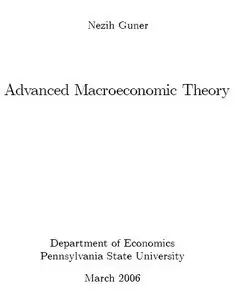"Advanced Macroeconomic Theory" by Nezih Guner
Lecture Notes
Department of Economics, Pennsylvania State University | 2006 | ISBN: n/a | 205 pages | PDF | 1 Mb
Lecture Notes
Department of Economics, Pennsylvania State University | 2006 | ISBN: n/a | 205 pages | PDF | 1 Mb
This is an introduction to modern macroeconomic theory. The main emphasis is the analysis of resource allocations in dynamic stochastic environments.
In an exchange economy people interact in the market place. They buy and sell goods taking market prices as given. They do this in order to maximize their utility. Their choices are constrained by their endowments.
Table of Contents
1. Walrasian (Competitive) Equilibrium
2. Exchange Economies with Infinitely-Lived Agents
3. Stochastic Endowments
3.1 Asset Pricing
4. Overlapping Generations
4.1 Exchange Economy
4.2 Competitive Equilibrium
4.2.1 Arrow-Debreu Equilibrium
4.2.2 Sequential Markets
4.3 Pareto Optimality in OLG models
4.4 Introducing a government
4.5 Intergenerational Linkages
4.6 Production
4.6.1 Individuals problem
4.6.2 Firms
4.6.3 Determination of kt
4.6.4 An Example4.7 Introducing Government
4.7.1 Pay-as-You-Go Social Security System
4.7.2 Income Taxes
4.8 Dynamic Efficiency
5. Dynamic Programming
5.1 Neoclassical Growth Model
5.2 Dynamic Programming: An Introduction
6. Mathematical Preliminaries
6.1 Vector and Metric Spaces
6.1.1 Supremum and Infimum
6.2 Sequences and Completeness
6.3 Three Cs: Closedness, Boundedness and Compactnessof Sets
6.4 Functions
6.5 Sequences of Functions
6.5.1 Pointwise Convergence
6.5.2 Uniform Convergence6.6 Contraction Mappings
6.7 Correspondences
6.7.1 Lower Hemi-Continuity
6.7.2 Upper Hemi-Continuity
6.8 The Theorem of Maximum
7. Principal of Optimality
7.1 FE with Bounded Returns
7.2 Unbounded Returns
8. Examples and Exercises
9. Deterministic Dynamics
9.1 Stationary Points of g(.)
10. Euler Equations
10.1 Solving Linear Di¤erence Equations
10.1.1 Two-dimensional case
10.1.2 General Case
10.2 Quadratic Return Functions
10.3 Linear Approximations
11. Stochastic Case - Finite Number of Shocks
11.1 Preliminaries
11.2 Transition Functions
11.3 Policy Functions and Transitions Functions
12 Markov Chains
12.1 Examples
12.2 Invariant Distributions
13. Recursive Competitive Equilibrium
14. Introduction to Numerical Methods
14.1 Deterministic Case
14.2 Stochastic Case
14.2.1 Tauchen's Method
14.2.2 Simulations
14.2.3 Calibration - Prescott (1986)
14.2.4 Linear Decision Rules
with TOC BookMarkLinks
More : You find here



